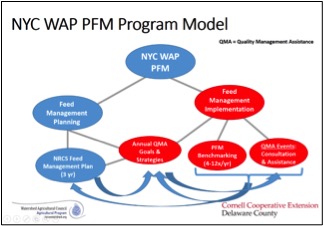Precision Feed Management
What We Do
Precision Feed Management (PFM) is designed to engage farmers in a recurring process of planning, implementation and monitoring of the largest source of nutrients on the farm – feed nutrients. Our reasons for implementing PFM are to improve animal productivity, improve profitability and to reduce nutrient accumulations on the farm. PFM is an ongoing management BMP and will be executed differently for each farms’ individual goals.
From the animal side, we help farmers and their feed nutritionists implement more tightly formulated diets that avoid overfeeding of nutrients and maximize use of homegrown nutrients. We also help them maintain healthy, comfortable and productive animals that convert feed nutrients into milk and meat more efficiently and increase exports of nutrients off the farm in milk and animal sales.
From the crop production side, we help farmers produce a larger quantity of higher digestible homegrown feed nutrients, which sets the stage for importing fewer purchased feed nutrients and increasing milk or meat production and milk or meat nutrient exports.
Originally a program focused on dairy, in 2020 Beef Precision Feed Management was designed, 18 farms were enrolled, and implementation began. Though it is the newest branch of the PFM program, we expect it to grow rapidly.
Check out the following Success Stories for PFM: Boots in the Barnyard: Dar-View Farm, Boots in the Barnyard: Springdale Farm
Feed Management Planners:
- Meghan Potter, PFM Team Leader
- April Wright-Lucas BS, CCA, PAS – PFM Specialist
- Shylabeth Taylor BS – PFM Specialist
- James Romack MS – PFM Specialist
PFM Planning and Implementation:
 PFM in the NYCWAP consists of 2 primary efforts; Planning and Implementation. The planning phase consists of constructing Feed Management Plans according the NY-USDA-NRCS 592 Feed Management Planning Standard. These Feed Management Plans are renewed every three years for a farm. The PFM planner also engage each farm in annual Quality Management Assistance goal setting. This helps the farmers focus on annual goals and helps the PFM planners know where they can assist the farm.
PFM in the NYCWAP consists of 2 primary efforts; Planning and Implementation. The planning phase consists of constructing Feed Management Plans according the NY-USDA-NRCS 592 Feed Management Planning Standard. These Feed Management Plans are renewed every three years for a farm. The PFM planner also engage each farm in annual Quality Management Assistance goal setting. This helps the farmers focus on annual goals and helps the PFM planners know where they can assist the farm.
The Implementation efforts include both technical assistance provided by the PFM planners to the farmers to implement their annual animal and crop production goals as well as regular monitoring of animal performance and diets. The monitoring of animals and diets is at the core of the quantification and documentation of dietary nutrient management and impact our program has on managing manure nutrient excretions and whole farm mass nutrient dynamics.
The PFM monitoring, also known as PFM Benchmarking consists of a process where our PFM Planners visit each of their farms quarterly or more frequently as needed. On these visits the planner works with the farmer to gather data on the cattle and feeds being offered, as well as take samples of each feed. These samples are sent out to DairyOne, Cumberland Valley Analytical Services, or Rock River Labs to be analyzed. Once the results are back, the planner takes this feed and cattle information and inputs it into our benchmark software to generate a benchmark for a given point in time. These benchmarks are assessed to identify dietary and animal trends and identify opportunities for improvement. When collected over time, these benchmarks show trends in a herd and help the PFM program track impact and plan future program efforts.
PFM Impacts by the Numbers:
In 2020, the fifth year of PFM implementation, PFM planners worked with 43 farms and 2,746 cows. The total amount of feed phosphorus and nitrogen placed under PFM management was 82,590 lbs and 509,073 lbs respectively. The pools of phosphorus (P) and nitrogen (N) represent an extremely large amount of P and N under management through Precision Feed Management program. For the 2020 planning year, the PFM program was able to achieve a net reduction in manure phosphorus excretions of 4,556 kg, the largest reduction to date for the program. Like phosphorus, the PFM program achieved its largest-ever net manure nitrogen excretion reduction across all herds in 2020, totaling 23,022 kg.
Quality Management Assistance (QMA) Impact Reports:
Click on the following links for success stories/examples of impact reports.
- Springdale Farm QMA Impact Report
- Tylervale Farm QMA Impact Report
- Green Heart Dairy QMA Impact Report
- Mushkoday Farm QMA Impact Report
Beef PFM:
Beef cattle production in the NYC watershed is a major agricultural enterprise which involves 57% of the farms and 34% of all the animal units enrolled in the NYCWAP included in the NYC watershed, Delaware County alone is ranked #2 out of all counties in New York for beef production.
Research has shown and local data has confirmed that beef cows excrete more phosphorus in their manure that dairy cattle of similar size.
Thus, there exists a significant opportunity to manage the nutrient mass balances and potential nutrient losses on beef farms for the purpose of protecting the water quality in the NYC reservoir system. This will help a major sector of the farm community to meet their goals, be sustainable and thrive in the watershed!
Beef PFM Program Objectives:
- Minimize overfeeding of phosphorus & nitrogen to beef herds.
- Facilitate producer education with the adoption of herd management practices.
- Achieve a feasible reduction in phosphorus mass balance with the participating farms.
- Have a positive impact on both the environment and economic viability of the farms participating in the program.
Currently the NYCWAP PFM program is working with 18 beef herds as we pilot development and implementation of PFM for beef herds.
